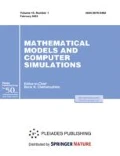Abstract
In this study we develop a modification of the high-resolution CABARET scheme for rotating meshes surrounded by an external fixed zone. CABARET is a second-order in space and time conservative/characteristic scheme with a compact stencil, which has low-dissipative and low-dispersive properties and is nonoscillatory for calculations involving nonlinear flow problems with a wide range of frequencies in computational aeroacoustics. To expand this method for the rotor-stator interaction problem, an approximation of the noninertial terms in rotating zones for conservative steps is added, and an appropriate modification of the characteristic step on the sliding interface is developed. An evolutionary approach, which ensures the preservation of the fluxes of conservative variables through the contact surface is implemented. The dispersion-improved version of the scheme with an added antidispersion term expressed via a flux derivative is added as well as a modification of the nonlinear flux correction algorithm with reduced dissipation. For testing, the problem of acoustic wave propagation through rotating zones and sliding interfaces is considered. It is shown that the developed C-ABARET method for rotating zones retains the main characteristics of the base CABARET algorithm on fixed meshes.








REFERENCES
V. M. Goloviznin and A. A. Samarski, “Finite difference approximation of convective transport equation with space splitting time derivative,” Mat. Model. 10 (1), 86–100 (1998).
S. A. Karabasov and V. M. Goloviznin, “Compact Accurately Boundary-Adjusting high-REsolution Technique for fluid dynamics,” J. Comput. Phys. 228 (19), 7426–7451 (2009). https://doi.org/10.1016/j.jcp.2009.06.037
A. Chintagunta, S. E. Naghibi, and S. A. Karabasov, “Flux-corrected dispersion-improved CABARET schemes for linear and nonlinear wave propagation problems,” Comput. Fluids 169, 111–128 (2018). https://doi.org/10.1016/j.compfluid.2017.08.018
V. A. Semiletov and S. A. Karabasov, “CABARET scheme with conservation-flux asynchronous time-stepping for nonlinear aeroacoustics problems,” J. Comput. Phys. 253, 157–165 (2013). https://doi.org/10.1016/j.jcp.2013.07.008
J. E. Ffowcs Williams, and D. L. Hawkings, “Sound generation by turbulence and surfaces in arbitrary motion,” Philos. Trans. R. Soc. A Math., Phys. Eng. Sci. 264 (1151), 321–342 (1969). https://doi.org/10.1098/rsta.1969.0031
G. A. Faranosov, V. M. Goloviznin, S. A. Karabasov, V. G. Kondakov, V. F. Kopiev, and M. A. Zaitsev, “CABARET method on unstructured hexahedral grids for jet noise computation,” Comput. Fluids 88, 165–179 (2013). https://doi.org/10.1016/j.compfluid.2013.08.011
A. P. Markesteijn, V. A. Semiletov, and S. A. Karabasov, “CABARET GPU solver for fast-turn-around flow and noise calculations,” in 21st AIAA/CEAS Aeroacoustics Conference, Dallas, TX, 2015, p. AIAA-2015-2223. https://doi.org/10.2514/6.2015-2223
A. P. Markesteijn, V. A. Semiletov, and S. A. Karabasov, “GPU CABARET solutions for the SILOET jet noise experiment: Flow and noise modelling,” in 22nd AIAA/CEAS Aeroacoustics Conference, Lyon, 2016, p. AIAA-2016-2967. https://doi.org/10.2514/6.2016-2967
A. P. Markesteijn and S. A. Karabasov, “GPU CABARET solutions for the NASA SHJAR jet noise experiment: Flow and noise modeling,” in 23rd AIAA/CEAS Aeroacoustics Conference, Denver, CO, 2017, p. AIAA 2017-3852. https://doi.org/10.2514/6.2017-3852
A. P. Markesteijn and S. A. Karabasov, “CABARET solutions on graphics processing units for NASA jets: Grid sensitivity and unsteady inflow condition effect,” C. R. Méc. 346 (10), 948–963 (2018). https://doi.org/10.1016/j.crme.2018.07.004
A. P. Markesteijn and S. A. Karabasov, “Simulations of co-axial jet flows on graphics processing units: The flow and noise analysis,” Philos. Trans. R. Soc. A Math. Phys. Eng. Sci. 377, 20190083 (2019). https://doi.org/10.1098/rsta.2019.0083
A. P. Markesteijn, H. K. Jawahar, S. A. Karabasov, and M. Azarpeyvand, “GPU CABARET solutions for 30P30N three-element high-lift airfoil with slat modifications,” in AIAA Aviation 2021 Forum(AIAA, 2021), p. AIAA 2021-2115. https://doi.org/10.2514/6.2021-2115
H. A. Abid, A. P. Markesteijn, and S. A. Karabasov, “Trailing edge noise modelling of flow over NACA airfoils informed by LES,” in AIAA Aviation 2021 Forum (AIAA, 2021), p. AIAA 2021-2233. https://doi.org/10.2514/6.2021-2233
F. Cariglino, N. Ceresola, and R. Arina, “External aerodynamics simulations in a rotating frame of reference,” Int. J. Aerosp. Eng. 2014, 654037 (2014). https://doi.org/10.1155/2014/654037
I. E. Sutherland and G. W. Hodgman, “Reentrant polygon clipping,” Commun. ACM 17 (1), 32–42 (1974). https://doi.org/10.1145/360767.360802
A. Chintagunta, S. E. Naghibi, A. P. Markesteijn, and S. A. Karabasov, “A fourth-order CABARET scheme for computational aeroacoustics,” Preprint (2018). https://doi.org/10.13140/RG.2.2.28629.88805
A. Chintagunta, S. E. Naghibi, A. P. Markesteijn, and S. A. Karabasov, “Dispersion Improved CABARET for computational aeroacoustics,” in 23rd AIAA/CEAS Aeroacoustics Conference, Denver, CO, 2017, p. AIAA 2017-4185. https://doi.org/10.2514/6.2017-4185
Funding
This study was supported by the Russian Science Foundation (grant no. 21-71-30016).
Author information
Authors and Affiliations
Corresponding author
Ethics declarations
The authors declare that they have no conflicts of interest.
Rights and permissions
About this article
Cite this article
Solntsev, I.A., Karabasov, S.A. Development of Unstructured Code for Rotating Zones Based on the Cabaret Method with Improved Spectral Properties. Math Models Comput Simul 15, 125–137 (2023). https://doi.org/10.1134/S207004822301012X
Received:
Revised:
Accepted:
Published:
Issue Date:
DOI: https://doi.org/10.1134/S207004822301012X

